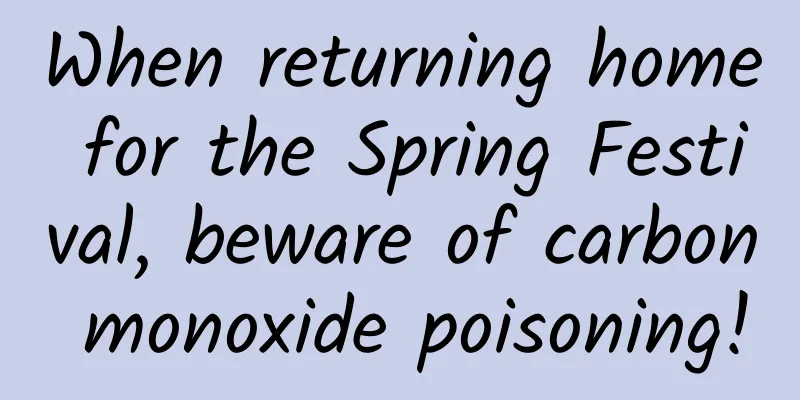When returning home for the Spring Festival, beware of carbon monoxide poisoning!

|
As the Spring Festival approaches, people who work away from home are returning to their hometowns to celebrate the New Year. The use of various heating equipment in every household is also more frequent. While bringing warmth and comfort to family reunions, various acute carbon monoxide poisoning incidents have also entered a high incidence period. Here we remind everyone to pay attention to safety when returning home for the Spring Festival and be careful of carbon monoxide poisoning! 1. Why does carbon monoxide poison people? Carbon monoxide is a colorless, odorless and non-irritating asphyxiating gas with a density slightly lower than that of air. Carbon monoxide in the environment is produced by incomplete combustion of carbon-containing substances, mainly from human activities. Image source: Nanchong Central Hospital Carbon monoxide enters the body through the respiratory tract. The affinity of carbon monoxide for hemoglobin is 200 times that of oxygen for hemoglobin. It can also form a chelate with the divalent iron ions in other heme proteins, cytochrome oxidase. When people stay in an environment with high concentrations of carbon monoxide, carbon monoxide will enter the blood through the respiratory tract, combine with hemoglobin to form carboxyhemoglobin, hindering the release and transfer of oxygen, leading to hypoxemia, and causing hypoxia in the body's tissues. In severe cases, it may endanger human life. Image source: Photo Network 2. What are the symptoms of carbon monoxide poisoning? The clinical manifestations of carbon monoxide poisoning are related to the concentration of carboxyhemoglobin in the body's blood According to the degree of poisoning Divided into mild, moderate and severe types Image source: Photo Network 1. Mild poisoning The concentration of carboxyhemoglobin in the blood is 10%-20%, and the main clinical symptoms are brain hypoxia, such as headache, dizziness, tinnitus, blurred vision, nausea, vomiting, limb weakness, and even short-term fainting. Patients with coronary heart disease experience angina pectoris. After quickly leaving the poisoning environment and breathing fresh air, the symptoms can disappear quickly, and generally there are no sequelae. 2. Moderate poisoning The concentration of carboxyhemoglobin in the blood is 30%-40%. In addition to the symptoms of mild poisoning, there are also symptoms such as cherry red skin and mucous membranes, flushed face, sweating, accelerated pulse, confusion, unsteady walking, blurred consciousness, drowsiness, decreased judgment, hallucinations, light coma, slow light reflex and corneal reflex. If rescued in time, the patient can quickly wake up and fully recover within a few days, generally without sequelae. Image source: Photo Network 3. Severe poisoning Excessive inhalation of carbon monoxide, carboxyhemoglobin in the blood has reached more than 50%, the patient will be in a deep coma or cerebral cortex state, various reflexes will be significantly weakened or disappeared, incontinence, cold limbs, pale lips and face or cyanosis, sweating, fever, blood pressure drop, respiratory depression. Severe poisoning patients have a high mortality rate, and survivors may have serious sequelae. Image source: Photo Network 3. How to prevent carbon monoxide poisoning? 1. Coal stoves, charcoal fires and other heating equipment First, in cold seasons, if conditions permit, try to choose central heating. When using coal stoves, charcoal fires and other heating equipment indoors, the coal should be burned out and the lid should not be covered; doors and windows should be opened frequently to ventilate and keep the indoor air fresh. Image source: Photo Network Secondly, the coal stove should be equipped with a chimney, and the chimney joint should be firmly connected (the thick end of the chimney should face the coal stove) to prevent air leakage; the chimney mouth should preferably be opened in the downwind direction, and the chimney extending outside should preferably be equipped with a wind shield or a bend to prevent strong winds from blowing the gas back into the house; the house must be equipped with a wind scoop, and the wind scoop is preferably installed above the doors and windows. Regularly check the stove, maintain and clean the chimney and wind scoop, and keep the chimney and wind scoop unobstructed. 2. Gas and coal gas water heaters When buying a gas or coal gas water heater, you need to choose a water heater produced by a regular manufacturer and of qualified quality; you must ask a professional to install it and use it only after it has passed the inspection. When using a gas or coal gas water heater, you must maintain good ventilation, do not take a bath for too long, and check whether the water heater is completely turned off after use. 3. Gas, gas stoves and pipelines When purchasing gas or coal gas stoves, you must choose those produced by regular manufacturers and of qualified quality; you must ask professionals to install them and use them only after they have passed the inspection. Do not change the gas or coal gas pipeline facilities without permission. When using gas or coal gas stoves, remember to stay away from them to prevent the pot from overflowing and extinguishing the stove fire, causing gas or coal gas to overflow. After use, check whether the stove is completely turned off. Image source: Photo Network 4. Cars When the vehicle is parked in a garage or basement, do not keep the engine running; when the vehicle is parked, do not turn on the air conditioner for a long time, and do not sleep in a car with the doors and windows closed and the air conditioner turned on. Regularly check the vehicle's exhaust system to prevent carbon monoxide leakage from the exhaust system. 4. How to deal with carbon monoxide poisoning 1. Cut off the source of carbon monoxide First, open the windows immediately to allow air convection, quickly turn off the gas/gas stove, water heater valve, pipeline gas, extinguish charcoal fire and other facilities and equipment, and be careful to avoid using lighters and other items that are easy to produce sparks. 2. Get out of the poisoning environment quickly Quickly remove the patient from the poisoning site and transfer him to a place with fresh air and good ventilation. Unbutton the collar of the poisoned person and keep the airway open; at the same time, pay attention to keeping warm to prevent complications. The patient should keep quiet and rest, avoid activities that increase oxygen consumption, and let the patient breathe oxygen as soon as possible if conditions permit. Image source: Photo Network For moderate to severe patients While providing first aid on the scene Call 120 emergency number immediately Send the patient to a hospital with a hyperbaric oxygen chamber for hyperbaric oxygen treatment as soon as possible For critically ill patients with respiratory and cardiac arrest Artificial respiration and cardiac massage should be given immediately At the same time, he was quickly transferred to the hospital for emergency treatment END Source: China CDC, Nanchong Central Hospital, Shandong Emergency Management Compiled by: Dong Xiaoxian Editor: Guru |
<<: Keep these 3 money-saving tips in mind to help you control your spending (theoretically)
Recommend
[Grain Policy of a Great Country] How does AI understand biological breeding? We tested Deepseek
How does AI understand biological breeding? We te...
Why buy an iPhone 11 for the same price? After trying out the vivo NEX3, I realized that this is the phone of the future.
The mobile phone market is becoming increasingly ...
New regulations on flat broadcast account creation tutorial: the underlying logic of flat broadcast account creation, suitable for the current account creation method
New regulations on Pingbo account creation tutori...
How were games developed 20 years ago?
[[145405]] Someone asked on Zhihu: "There ar...
StateBackgroundUtil - Use only one resource image to set a background with a pressed effect for View
This article mainly introduces how to use a resou...
Trivia | What can you use to ward off vampires? Garlic?
What to use to ward off vampires, garlic? Written...
How to create a popular short video with high exposure
Tik Tok, the short video app that has exploded in...
It's so itchy! How to deal with these "little blisters" that often appear on your hands in summer?
Every time this season comes, many people develop...
What are the equipment that can be connected to the real-name system on construction sites?
At present, the country is vigorously promoting t...
Don’t just stare at the screen and laugh, you need a guide to protecting your eyes from electronic devices!
I often see parents asking what are the better ey...
Understand the central bank’s reserve requirement cut in 30 seconds!
Mixed Knowledge Specially designed to cure confus...
One-minute science | Why do plants in the desert grow in such strange shapes?
What are desert plants? Desert plants generally r...
Controversy in iOS development
[[129662]] I plan to share some controversial top...
Tesla Motors changes its name to remove the word "car": its ambition has no boundaries
Tesla Motors Inc, a well-known American innovativ...
Don't ignore it! Poisonous insects are more terrible than mosquitoes. They take advantage of people's unpreparedness to launch a "killer weapon"?
At this time of year every year, Uncle Wang would...









